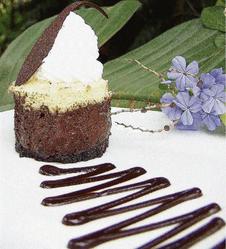Hmmm! Rich, chocolate-covered desserts, olives and all kinds of delightful nuts and seeds. Sounds scrumptious and, at last, all part of a waistline-friendly diet that doesn't tell us to eat tasteless rice cakes and drink cabbage soup.
Foods like these are now being called 'flat-belly foods'. Quite a few studies and a recently published diet book called, The Flat Belly Diet, have been touting the idea that we can lose belly fat by eating a 1,600-calorie diet which is rich in monounsaturated fats (MUFAs).
Chocolate, olives, seeds and nuts, avocado and some oils (for example, canola, flaxseed, olive, safflower, sesame, walnut) are all rich in MUFAs. The studies are indicating that diets rich in MUFAs reduce belly fat as these healthy fats are said to increase people's fat burning ability and to attack the fat that sits around the waistline.
MUFAs, polyunsaturated fats and omega-3 fatty acids - the healthy fats - have long been prized for lowering heart disease risk by cutting total and low-density lipoprotein (LDL) cholesterol level in blood. Cholesterol, produced by the body for cell building, is the main substance in fatty deposits or plaque that can develop in arteries.
No magic foods
But not all nutrition scientists are gung-ho about MUFAs as flat-belly foods. Some international experts say that most people on a diet of 1,600 calories will lose weight anyway and question whether there can be magic foods or even exercises that can clinically target belly fat. (You can read more of their views on www.webmd.com.)
Other critics also say that MUFAs, though they are healthy fats, like all fats have nine calories per gram which is more than twice the amount of calories per gram in proteins and carbohydrates, each of which carries four calories per gram. These experts, however, are not gainsaying that MUFA-rich foods are good for us with proven health benefits.
eulalee.thompson@gleanerjm.com

Five choices
Five foods rich in MUFAs and which are part of the flat-belly diet are nuts and seeds, oils, avocado, olives and chocolate. This diet recommends that you eat at least one serving of a MUFA-rich food with each meal while paying attention to calorie intake.
Nuts and seeds
You can have your pick of MUFA-rich nuts and seeds - walnuts, almonds, dry-roasted cashews, dry-roasted peanuts, dry-roasted sunflower seeds, hazel nuts, pecan, peanut butter, cashew butter, dry-roasted pumpkin seeds, pistachios and so on. A serving is two tablespoons.
Research is showing that walnuts stand out among the nuts. Walnuts are one of the best plant sources of protein; rich in fibre, the B and E vitamins, magnesium and antioxidants. Walnuts are also reported to have significantly higher amounts of omeg-3 fatty acids when compared to other nuts.
Oils
MUFA-rich oils include olive, canola, sesame, flaxseed, peanut, walnut, soybean and safflower oils as well as pesto sauce. A serving of oil in this diet is actually one tablespoon.
Avocado
Avocado can be served in many interesting ways and one serving is quarter cup.
Olives
Olives were considered sacred by the Greeks and as a symbol of goodness and nobility. Most people would be aware that olive branches are still considered a symbol of peace. The olive juice or olive oil is an excellent source of antioxidants and contains MUFAs which help to control cholesterol.
Olive's taste and aroma are linked to substances called polyphenols which are anti-cancer and anti-inflammatory.
There are green and black olives which can be sliced, eaten as snacks, placed in salads, pastas and so on.
A serving is 10 large olives.
Chocolate
Most people's favourite chocolate is also a MUFA-rich food; a serving is quarter cup.

